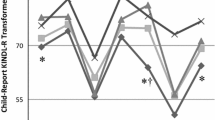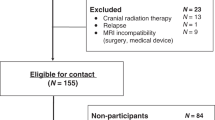Abstract
Adaptive functioning is not often examined in childhood brain tumor (BT) survivors, with the few existing investigations relying on examiner interviews. Parent questionnaires may provide similar information with decreased burden. The purpose of this study was: (1) to examine adaptive behaviors in BT survivors relative to healthy peer and cancer survivor groups, and (2) to explore the validity of a parent questionnaire in relation to an examiner administered interview. Participants (age 13.11 ± 2.98 years) were BT survivors treated with conformal radiation therapy (n = 50), healthy siblings of BT survivors (n = 39) and solid tumor (ST) survivors who did not receive CNS-directed therapy (n = 40). Parents completed the Adaptive Behavior Assessment System–2nd Edition (ABAS-II). For a subset of the BT cohort (n = 32), examiners interviewed the parents using the Vineland Adaptive Behavior Scales (VABS) within 12 months. Groups differed significantly on each of the ABAS-II indices and the general adaptive composite, with the BT group scoring lower than the sibling and ST groups across indices. Executive functioning, but not IQ, was associated with adaptive skills; no clear pattern of clinical and demographic predictors was established. VABS scores were correlated with ABAS-II scores on nearly all indices. BT survivors showed significantly lower adaptive functioning when compared to healthy and cancer controls. The ABAS-II proved sensitive to these behavioral limitations and was consistent with scores on the VABS. The use of a parent questionnaire to assess adaptive functioning enhances survivorship investigations by increasing flexibility of assessment and decreasing examiner burden.

Similar content being viewed by others
References
Sparrow SS, Balla DA, Cicchetti DV (1984) Vineland adaptive behavior scales. American Guidance Service Inc, Circle Pines
Roizen NJ, Blondis TA, Irwin M, Stein MA (1994) Adaptive functioning in children with attention-deficit hyperactivity disorder. Arch Pediatr Adolesc Med 148(11):1147–1232
Stein MA, Szumowski E, Blondis TA, Roizen NJ (1995) Adaptive skills dysfunction in ADD and ADHD children. J Child Psychol Psychiatry 36(4):663–670
Ris MD, Beebe DW, Armstrong FD, Fontanesi J, Holmes E, Sanford RA, Wisoff JH, Children’s Oncology Group (2008) Cognitive and adaptive outcome in extracerebellar low-grade brain tumors in children: a report from the Children’s Oncology Group. J Clin Oncol 26(29):4765–4770
Mulhern RK, Horowitz ME, Kovnar EH, Langston J, Sanford RA, Kun LE (1989) Neurodevelopmental status of infants and young children treated for brain tumors with preirradiation chemotherapy. J Clin Oncol 7(11):1660–1666
Stargatt R, Rosenfeld JV, Anderson V, Hassall T, Maixner W, Ashley D (2006) Intelligence and adaptive function in children diagnosed with brain tumour during infancy. J Neurooncol 80(3):295–303
Papazoglou A, King TZ, Morris RD, Morris MK, Krawiecki NS (2008) Attention mediates radiation’s impact on daily living skills in children treated for brain tumors. Pediatr Blood Cancer 50(6):1253–1257
Netson KL, Conklin HM, Wu S, Xiong X, Merchant TE (2012) A 5-year investigation of children’s adaptive functioning following conformal radiation therapy for localized ependymoma. Int J Radiat Oncol Biol Phys 84(1):217–223
Netson KL, Conklin HM, Wu S, Xiong X, Merchant TE (2012) Longitudinal investigation of adaptive functioning following conformal irradiation for pediatric craniopharyngioma and low-grade glioma. Int J Radiat Oncol Biol Phys 85(5):1301–1306
Jalali R, Dutta D, Develekar R, Sarin R (2007) Prospective assessment of ADL using Barthel’s scoring system in children with low grade brain tumours treated with SCRT. Pediatr Blood Cancer 49(4):430
Jalali R, Dutta D, Kamble R, Gupta T, Munshi A, Sarin R, Dinshaw K (2008) Prospective assessment of activities of daily living using Modified Barthel’s Index in children and young adults with low-grade gliomas treated with stereotactic conformal radiotherapy. J Neurooncol 90:321–328
Merchant TE, Mulhern RK, Krasin MJ, Kun LE, Williams T, Li C, Xiong X, Khan RB, Lustig RH, Boop FA, Sanford RA (2004) Preliminary results from a phase II trial of conformal radiation therapy and evaluation of radiation-related CNS effects for pediatric patients with localized ependymoma. J Clin Oncol 22(15):3156–3162
Conklin HM, Li C, Xiong X, Ogg RJ, Merchant TE (2008) Predicting change in academic abilities after conformal radiation therapy for localized ependymoma. J Clin Oncol 26(24):3965–3970
Kun LE, Mulhern RK, Crisco JJ (1983) Quality of life in children treated for brain tumors. Intellectual, emotional, and academic function. J Neurosurg 58(1):1–6
Mulhern RK, Merchant TE, Gajjar A, Reddick WE, Kun LE (2004) Late neurocognitive sequelae in survivors of brain tumours in childhood. Lancet Oncol 5(7):399–408
Butler RW, Haser JK (2006) Neurocognitive effects of treatment for childhood cancer. Ment Retard Dev Disabil Res Rev 12(3):184–191
Packer RJ, Gurney JG, Punyko JA, Donaldson SS, Inskip PD, Stovall M, Yasui Y, Mertens AC, Sklar CA, Nicholson HS, Zeltzer LK, Neglia JP, Robison LL (2003) Long-term neurologic and neurosensory sequelae in adult survivors of a childhood brain tumor: childhood cancer survivor study. J Clin Oncol 21(17):3255–3261
Merchant TE, Conklin HM, Wu S, Lustig RH, Xiong X (2009) Late effects of conformal radiation therapy for pediatric patients with low-grade glioma: prospective evaluation of cognitive, endocrine, and hearing deficits. J Clin Oncol 27(22):3691–3697
Harrison PL, Oakland T (2003) Adaptive behavior assessment system, 2nd edn. The Psych Corp, San Antonio
Wechsler D (1999) Wechsler abbreviated scale of intelligence. Harcourt Assessment, San Antonio
Gioia GA, Isquith PK, Guy SC, Kenworthy L (2000) Behavior rating inventory of executive function. Psychological Assessment Resources Inc, Odessa
Barratt WR. The Barratt Simplified Measure of Social Status. Retrieved from the Indiana State University website: http://socialclassoncampus.blogspot.com/2012/06/barratt-implified-measure-of-social.html. Accessed 14 Jun 2012
Howarth RA, Ashford JM, Merchant TE, Ogg RJ, Santana V, Wu S, Xiong X, Conklin HM (2013) The utility of parent report in the assessment of working memory among childhood brain tumor survivors. J Int Neuropsychol Soc 19(4):380–389
Stavro GM, Ettenhofer ML, Nigg JT (2007) Executive functions and adaptive functioning in young adult attention-deficit/hyperactivity disorder. J Int Neuropsychol Soc 13(2):324–334
Ware AL, Crocker N, O’Brien JW, Deweese BN, Roesch SC, Coles CD, Kable JA, May PA, Kalberg WO, Sowell ER, Jones KL, Riley EP, Mattson SN, CIFASD (2012) Executive function predicts adaptive behavior in children with histories of heavy prenatal alcohol exposure and attention deficit/hyperactivity disorder. Alcohol Clin Exp Res 36(8):1431–1441
Ris MD, Packer R, Goldwein J, Jones-Wallace D, Boyett JM (2001) Intellectual outcome after reduced-dose radiation therapy plus adjuvant chemotherapy for medulloblastoma: a Children’s Cancer Group study. J Clin Oncol 19(15):3470–3476
Mabbott DJ, Penkman L, Witol A, Strother D, Bouffet E (2008) Core neurocognitive functions in children treated for posterior fossa tumors. Neuropsychology 22(2):159–168
Ellenberg L, Liu Q, Gioia G, Yasui Y, Packer RJ, Mertens A, Donaldson SS, Stovall M, Kadan-Lottick N, Armstrong G, Robison LL (2009) Neurocognitive status in long-term survivors of childhood CNS malignancies: a report from the Childhood Cancer Survivor Study. Neuropsychology 23(6):705–717
Moore DJ, Palmer BW, Patterson TL, Jeste DV (2007) A review of performance-based measures of functional living skills. J Psychiatr Res 41(1–2):97–118
Patterson TL, McKibbin C, Taylor M, Goldman S, Davila-Fraga W, Bucardo J, Jeste DV (2003) Functional adaptation skills training (FAST): a pilot psychosocial intervention study in middle-aged and older patients with chronic psychotic disorders. Am J Geriatr Psychiatry 11(1):17–23
Eapen V, Črnčec R, Walter A (2013) Clinical outcomes of an early intervention program for preschool children with Autism Spectrum Disorder in a community group setting. BMC Pediatr 13(1):3
Reichow B, Barton EE, Boyd BA, Hume K (2012) Early intensive behavioral intervention (EIBI) for young children with autism spectrum disorders (ASD). Cochrane Database Syst Rev. doi:10.1002/14651858.CD009260.pub2
Whitlock JA, Hamilton BB (1995) Functional outcome after rehabilitation for severe traumatic brain injury. Arch Phys Med Rehabil 76(12):1103–1112
Yip BC, Man DW (2009) Virtual reality (VR)-based community living skills training for people with acquired brain injury: a pilot study. Brain Inj 23(13–14):1017–1026
Acknowledgments
The authors thank the patients and their families who volunteered their time to participate in this study. This work was supported in part by the National Cancer Institute (St. Jude Cancer Center Support [CORE] Grant [P30 CA21765]; H.C., R21 CA131616); the International Neuropsychological Society (H.C., Rita G. Rudel Award); and the American Lebanese Syrian Associated Charities (ALSAC). Portions of this paper were presented at the annual meeting of the International Neuropsychological Society in Boston, MA, 2011.
Conflict of interest
The authors have no conflicts of interest to disclose.
Author information
Authors and Affiliations
Corresponding author
Rights and permissions
About this article
Cite this article
Ashford, J.M., Netson, K.L., Clark, K.N. et al. Adaptive functioning of childhood brain tumor survivors following conformal radiation therapy. J Neurooncol 118, 193–199 (2014). https://doi.org/10.1007/s11060-014-1420-7
Received:
Accepted:
Published:
Issue Date:
DOI: https://doi.org/10.1007/s11060-014-1420-7




